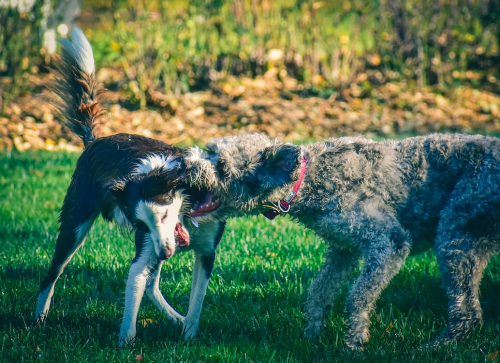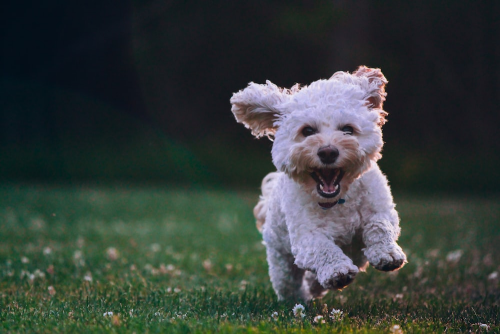Being a responsible dog owner means you need to carefully observe your dog’s behavior and stay attentive to any changes, as they may indicate underlying issues. This guide will assist you in understanding your dog’s behavior and identifying body language cues.
1. Tail Wagging
Tail wagging means your dog is emotionally aroused. This arousal could be due to excitement, but it could also be due to frustration or other negative emotions. To correctly interpret a dog’s feelings and intentions, pay attention to the speed and direction of the wag and the tail’s position.
A slow and gentle tail sweep means your pooch is relaxed and content. On the other hand, a faster, twitch-like wag suggests a higher level of arousal, which may be negative in nature. Imagine a guard dog being on alert, and you’ll have an idea of what this looks like.
2. Digging
Digging is a natural behavior for dogs, and it’s not uncommon for them to engage in it occasionally. If your pup digs in the backyard while having fun, there’s usually no need to worry. However, if this behavior becomes chronic, leading to numerous holes in your yard, it’s time to take action.
There are various reasons why dogs dig. These reasons can be connected to psychological issues, anxiety, or insufficient exercise.

3. Circling
Does your dog go round and round chasing its tail? Don’t worry; it’s a pretty common thing among dogs. Sometimes, it’s just a playful and natural behavior. However, keep an eye out if your furry friend does it excessively, as it could be a sign of some health or behavior issue.
If your dog is gnawing at its tail when it manages to catch it, there might be an issue with its skin or anal glands. And if tail chasing becomes a constant and intense obsession, it could be a sign of an obsessive-compulsive disorder.
4. Closing the Mouth
When your dog’s mouth is closed or slightly opened in its normal position, you can tell that it’s feeling relaxed and content. On the other hand, if its mouth is closed but pulled back, it could indicate stress, fear, submission, or pain.
It’s worth noting that some dogs may have their mouths pulled back even when they are happy and at ease. Thus, for a thorough understanding of your dog’s behavior correctly, you might need to monitor your furry companion closely.
5. Chewing
Just like a toddler, your dog might feel the urge to chew on objects and toys to ease the discomfort of new teeth. Even if your dog is fully grown, you might return home to find your couch cushions or favorite shoes in tatters, but it’s not because they find the taste appealing. This behavior could be a sign of anxiety or separation anxiety in general that they are experiencing.
6. Licking Lips
When a dog licks its lips, it often indicates that it’s feeling stressed or unsure about something. Occasionally, this body language might signal that your furry friend is sexually active. Moreover, if you observe it licking the lips of other dogs, it’s a sign that it’s not quite ready to be friends with them. This behavior is particularly common among puppies.
7. Pressing the Head
If you see your dog pressing their head against a wall or any solid object, you need to act swiftly. Head pressing is a significant indication of various serious issues, such as brain disease or poisoning. Don’t delay and schedule an appointment with your dog’s veterinarian right away.
8. Panting
Dogs pant to regulate their body temperature and cool down since they don’t sweat like humans. Panting allows them to exchange air through their mouths, but it’s not very efficient. Apart from understanding your dog’s behavior, you should take measures to keep your dog cool and prevent heat exhaustion.
Sometimes, dogs may pant due to anxiety, stress, or fear. In such cases, the best thing to do is remove them from the stressful situation. Panting can also be a sign of illness or injury in dogs. If you’re concerned about your dog’s panting, contact your vet without delay.
9. Pricking Ears
When your dog is aggressive, curious, or in the mood to play or chase, it will hold its ears forward or up. On the other hand, if it keeps its ears flat and close to its head, it’s a sign that it’s feeling scared or insecure. Moreover, if its ears are apart but not flat, it’s likely to be feeling sad or unsure. Understanding your dog’s behavior by paying attention to its ear positions can give you valuable insights into your dog’s emotions.
10. Biting
Puppies may nip at other dogs or people as they instinctively learn their place in their pack or family, which is normal behavior. However, when biting continues beyond puppyhood or becomes harmful, it might be a reason for concern. Some dogs may resort to biting when they feel threatened, are in pain, or are protecting their territory.

Some dogs exhibit dominance aggression, which can be potentially dangerous. Understanding your dog’s behaviors and addressing them will help you maintain a safe and harmonious environment for everyone involved.
11. Growling
When your furry friend makes a low or medium growling sound, with or without bark, it may be feeling territorial, threatened, or protective. This behavior could escalate into aggression, potentially leading to attacks on people or other animals. On the other hand, your dog might produce a soft growl when it’s content, alert, or in a happy and playful mood.

Ensure Your Dog Lives a Healthy and Happy Life
Understanding your dog’s behavior is key to building a strong and harmonious bond with your furry friend. By paying attention to their body language, vocalizations, and actions, you can gain valuable insights into their emotions and needs. Remember, every dog is unique, and getting to know their individual quirks will strengthen your relationship.
If your furry friend is not getting sufficient exercise, you can sign it up for doggy daycare near Indian Wells, CA. Get in touch with us at our pet care near Indian Wells now.



Recent Comments